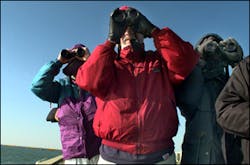Meeting Homeland Security Requirements for the Chesapeake Bay Bridge-Tunnel
CAPE CHARLES, Va. -- Chesapeake Bay Bridge-Tunnel commissioners approved a compromise Tuesday keeping islands along the 20-mile span open to birding while maintaining tighter post-Sept. 11 security measures.
The new rules will require birders to arrange their visits in advance, provide photo identification and be subject to security checks.
Birders will also be accompanied by security staff during their visits and groups will have to pay a $50 fee to cover costs for an escort.
''Apparently these islands we have here are one of the premiere bird-watching spots in the world,'' said Lucius J. Kellam III, commission chairman and interim executive director.
The bridge-tunnel's administration announced in March that three of the four islands on the crossing would be off-limits to birding as of April 1. The plan, however, was met with hundreds of protest letters and a committee of commission members and birding representatives was formed to work out the compromise announced Tuesday.
Bird watching was allowed to continue as usual on the islands, which provide a rest stop for East Coast migratory birds, until June 1.
''The islands are pretty unique in Virginia,'' said Paul Mocko of McLean, who runs an Internet listserv for bird watchers. ''They give birds a kind of a stopover in the middle of the bay.''
He said the islands attract birds usually seen farther north, such as the harlequin duck, great cormorant and common eider.
In addition, Mocko said, the islands are more easily accessible than the barrier islands off the Eastern Shore, which also attract a number of rare species but have to be reached by boat.
Kellam has said it was necessary to step up security on the bridge-tunnel, which is a transportation link to the military in Hampton Roads.
Birding will not be affected on the fourth island, which is open to the public, but it is lighted and noisy and provides the fewest sightings, the hobbyists have said.
